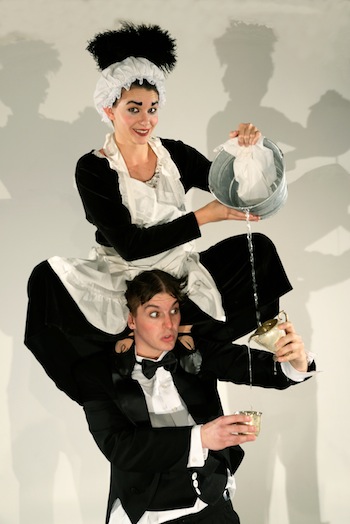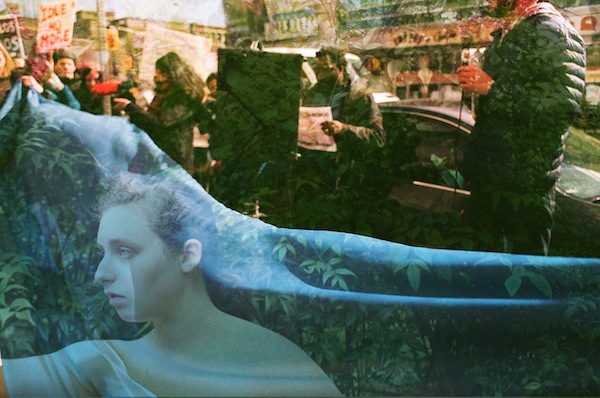Dalia Levy, left, and Ariel Martz-Oberlander (photos from Vines Art Festival)
“Good art is accountable to the community, raises up voices rarely heard and is vital to repairing our world.” This is a quote from Jewish community member Ariel Martz-Oberlander’s bio. It is little surprise that she was the associate producer for Vines Art Festival last year and is once again one of the artists this year.
Martz-Oberlander will be joined at Vines by several fellow Jewish community members: interdisciplinary artist Barbara Adler, textile artist Dalia Levy and performer and storyteller Naomi Steinberg, as well All Bodies Dance, of which Naomi Brand is a co-founder and facilitator. The multidisciplinary eco-arts festival features more than 70 performing and visual artists at parks throughout Vancouver.
According to its mission statement, Vines “is a free public event that creates platforms for local artists and performers to create with and on the land, steering their creative impulses toward work that focuses on the environment – whether a deep love of nature, sustainability or climate justice.”
“Everything I create is in relation to the land I find myself on and the times I was born into,” Martz-Oberlander told the Independent. “I create from a place of wanting to live in good relation to the land and those who have been protecting it since the beginning. I also create with the hope of telling the stories we need to bring about tikkun olam, the stories that have been buried or hidden as we struggled to survive by assimilation. Telling my stories is part of my larger work of decolonizing theatre and performance – making space for other silenced stories, and dismantling and rethinking the ways we tell stories in the first place.”
About the specific work that she will present at the festival, Martz-Oberlander, who divides her time between theatre and community organizing, said, “My piece, entitled on behalf of my body, explores living in the body after sexual trauma and touches on the intersectionality of sexual violence, PTSD, dissociation and separation from the self. The piece is also an exploration of how the settler body can live in Turtle Island, as approached through the story of my Ashkenazi diasporic and refugee ancestry.
“I am making this piece because I struggle with my place on this land, having no homeland of my own, but still being an uninvited guest. My people have been wandering for 2,000 years, and now I find myself here – my body a site of so many struggles, politicized without my permission by the forces of antisemitism, racism, nationalism, Western medicine, patriarchy and rape culture. How do I walk back into my body after being forced from it in so many ways? What does recovery mean when I’m not sure what was there before or whether I can get back there. Was there a before?
“This is the journey I invite you to go on with me – it’s going to be a wild ride.”
Levy will be presenting Connective [T]issue at Vines.
“Inspired by women’s Arpilleras [brightly coloured patchwork images] of [Augusto] Pinochet’s Chile, this knit/sewn/embroidered piece protests the Pacific garbage patch and extractive economies, like bitumen on our coast,” Levy explained. “As the same criminal mentality of supremacy exhibited under a dictatorship disappears our earth and our humanity, the piece simultaneously contrasts the powerful sources of life embedded into all of us. Representative of the underground connective channels that create the webs of mycelium our entire planetary eco-system grows from, the netting gives further conceptual insights of life woven into all DNA. With women’s traditional textile knowledge as a means to subvert and survive, the piece protests the private and normalized plunder blanketing earth and the interwoven convergence of issues in an era of global crisis.”
Connective [T]issue builds off her performance art installation at the festival last year, which was called Knit Piece, she said. “I used natural red dye from local berries to cover myself in the blood of the earth and proceeded to knit a giant umbilical cord drawing fundamental connections between humans and Mother Earth. The umbilical cord was then attached to knit anatomical hearts, and left in the park as a ‘yarnbomb’ installation. You can see a photo of one of the hearts here: permacultureartisan.com.
“Knit Piece and this year’s piece will be accompanied by a relevant sound art soundtrack to encourage further reflection,” she added.
About her work in general and how it relates to the environmental justice focus of the festival or connects to Judaism or Jewish culture, Levy said, “My work is very much focused on using the traditions of my Jewish foremothers to highlight the massive injustices of today. By reconnecting with these folk traditions that women used to pass down through generations, I am able to find a voice for myself beyond the domestic craft sphere while keeping these ingenious skills alive. My work is in protest of the extractive, discard culture embodied in consumer culture, as every inch of my work has been hand-stitched by myself from upcycled and found materials headed for the landfill. The environmental themes I work with relate directly to Vines as a vehicle for system change and awareness-raising about the destruction to our sacred planet.
“My Jewish ancestors that escaped Eastern Europe stitched their way across an ocean, escaping dictatorships that were extremely antisemitic, and began working as tailors and settling in Winnipeg’s Jewish community,” she continued. “My work is, therefore, informed by this family history that literally survived the pogroms because of our ability to stitch and make and adapt. I feel strongly that our future rests in this spirit of humble handmade [things] that is full of sustainable, ‘slow’ knowledge adaptable to climate change and a post-carbon economy.”
Vines Art Festival is an all-ages event and, while it runs from Aug. 8 to 19 in various Vancouver parks, the main program takes place Aug. 18, 1-7:30 p.m., at Trout Lake Park. All of the festival presentations are free. For the schedule, visit vinesartfestival.com.




